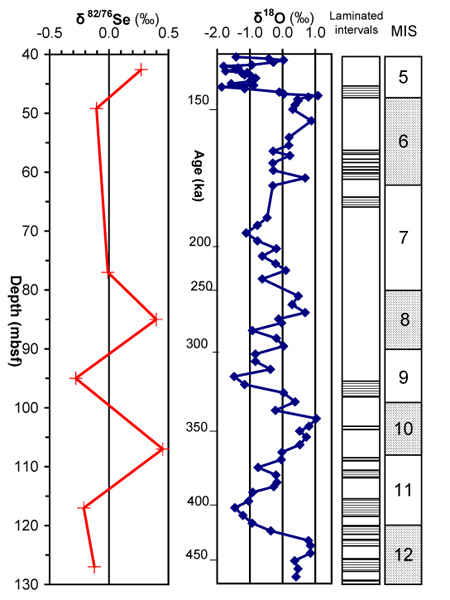
ACS PRF | ACS
All e-Annual Reports

42781-AC2
Global ocean oxygenation through geological time from selenium isotopes
Oxygenation of ancient oceans is difficult to constrain and while numerous local indicators exist, only a few isotope systems, e.g. S and Mo, have been used to investigate the global degree of ocean oxygenation. Understanding past global ocean oxygenation through selenium (Se) isotopes will provide important constraints on atmospheric O2 and help in understanding the development and evolution of life. From consideration of the known geochemical cycling and isotope fractionation behaviour of Se, our hypothesis is that significant seawater Se-isotope variations preserved in the sedimentary record should reflect changes in global ocean oxygenation through geological time. Our goal is to develop this idea into a practical palaeoredox proxy for palaeoceanography.
The second year of this project has continued to concentrate on samples from the Cariaco Basin, Venezuela because these sediments represent an ideal natural laboratory in which to test our predictions of the variations in Se isotope ratios of sediment formed under different seawater oxidation states. The alternating anoxic - oxic conditions observed in the Cariaco Basin have been correlated with the interglacial - glacial pattern which characterises the Quaternary. The dominant cause of this switch is glacioeustatic sea level fluctuations which alter the nutrient supply from the ocean to the basin over marginal sills.
Graduate student Andrew Shore spent two months in America at the University of Illinois, Urbana-Champaign (UIUC) under the supervision of Professor Johnson. There, he continued developing the sequential selective leaches in order to liberate the different Se components that make up each sample. Simultaneously the first Se isotope measurements were made on whole rock samples and, as these proved to be interesting, this line of investigation became the focus of activity in the short term. Se isotope ratios on all the whole rock samples have now been measured using the Nu Plasma multi-collector ICP-MS at UIUC.
In the 40 - 130 m interval (see figure) δ82/76Se values alternate with the change in the marine isotope stages (MIS). Relatively heavier Se isotope ratios characterise the cold, glacial isotope stages (even numbers; heavy δ18O) with relatively lighter Se isotope ratios in the warmer, interglacial isotope stages (odd numbers; light δ18O). Se isotope ratios also correlate with a number of other palaeoceanographic proxies (Mo, Fe, Mn etc). These patterns suggest that Se isotopes are recording some palaeoceanographic parameter from the geological record. Counter-intuitively, the pattern of Se isotope ratios described is the opposite of what might be predicted from the known fractionation behaviour if the oceanic Se isotope ratio was constant.
To explain the pattern of Se isotopes requires, as outlined in our original proposal, the effect on the global Se isotope system of basins that are periodically anoxic to be understood. On the basin-scale, sediments deposited under an anoxic water column are predicted to be dominated by relatively isotopically heavy organically-bound Se with a value close to seawater. Sediments deposited under an oxic water column have an increased proportion of authigenic Se which has a relatively lighter isotope signature.
However, we believe that the measured isotope ratios are illustrating a global Se seawater signature and should be explained with reference to the Degree of Anoxia (DOA) of the worlds oceans. When the DOA of the oceans is high, mass balance constrains the δSe value of the organic fraction (dominant sink) and the seawater to be similar to that of the weathering input into the ocean (relatively light δSe). During times of low DOA, with decreased deposition under anoxic water, mass balance constrains the δSe of the authigenic fraction (dominant sink) to be similar to the weathering input, resulting in the seawater, and phases precipitated from it, being characterised by relatively heavier δSe values.
In order to further test the applicability of Se isotopes as a global palaeoredox proxy, a set of sixty samples have been obtained from ODP Leg 172 (Northwest Atlantic Sediment Drifts). Our aim is to study the behaviour of selenium in Recent ocean sediments under a continuously oxic water column. We predict that the selenium isotope ratios will mirror those in the Cariaco Basin and will record the variation in the proportion of anoxic to oxic sedimentation occurring elsewhere in the global ocean at that time. This project will be collaborative with the British Geological Survey (BGS) where Se concentrations will be analysed by HG-AFS.
Andrew presented a poster detailing the Se isotope data that has been collected during his second year at the Geological Society's Bicentennial Conference in London in September 2007. He also attended a Natural Environmental Research Council ICP Facility two-day training course on "Introduction to Sample Preparation and ICP-AES Analysis."
Figure caption: δ82/76Se and δ18O for the Cariaco Basin (ODP Leg 165). Shaded even numbers represent glacials (oxic) and odd numbers represent interglacials (anoxic).
